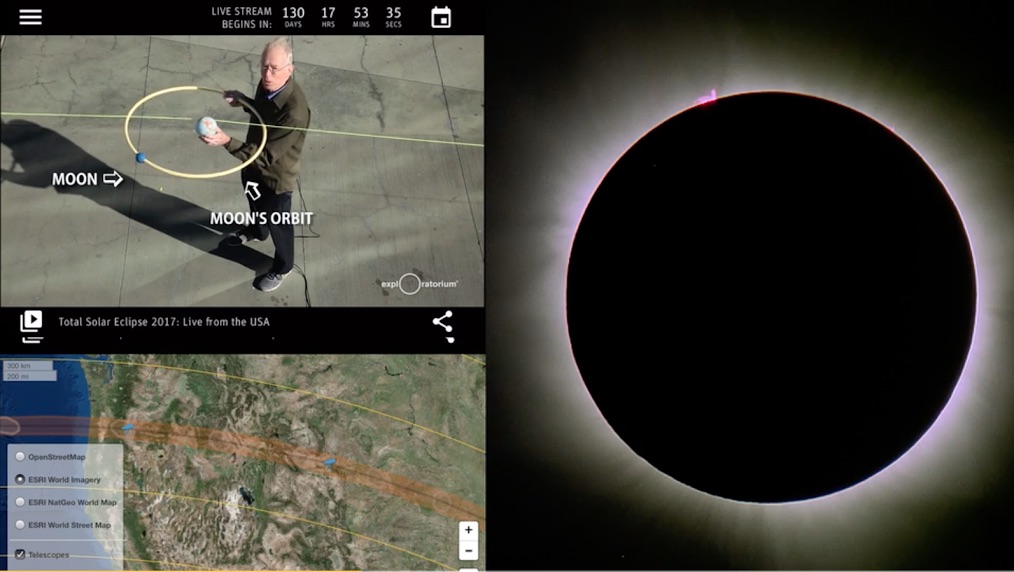New Mobile App from Exploratorium Museum Explores Solar Eclipse Science
A new mobile app from San Francisco's Exploratorium science museum lets users dig into the science behind the most extraordinary celestial event of the year: the total solar eclipse that will sweep across the United States on Aug. 21.
The app provides fascinating science facts about what happens during a total solar eclipse, as well as helpful information for how to view the eclipse safely.
"It includes a lot of basic astronomical science, but for those who want to go deeper, it also provides a chance to spend time exploring past astronomical events and some fascinating principles of physics responsible for the mechanics of an eclipse," Robyn Higdon, director of museum experiences at the Exploratorium, said in a statement. "I can see this app being used in classrooms as well as in living rooms."
If you can't make it out to witness the event, you can watch a livestream of the eclipse on the app, which you can share to larger screens using HD video. The app enables users to move seamlessly among the Exploratorium's five livestreams of the eclipse, museum representatives said in the statement.

These live feeds will include telescopic views from Wyoming and Oregon, English- and Spanish-language programs with discussions from scientists at both the Exploratorium and NASA, and a live musical performance that's billed as a "sonification" of the eclipse.
The Exploratorium has been hosting "livestreams" of eclipses for more than 25 years — long before most people were regularly using the internet. For example, in the early 1990s, Larry Shaw, one of the Exploratorium's early scientists and the creator of "Pi Day," created a "livestream" of an eclipse using radio waves, according to the statement. Last year, the institution worked with engineers to develop a high-dynamic-range camera that processes light similarly to the way the human eye does.
"Typically, photographs you see of a solar eclipse are composites of many shots taken to show different values on the light spectrum," Paul Doherty, a senior scientist at the Exploratorium and a physicist at the Massachusetts Institute of Technology, said in the statement.
Get the Space.com Newsletter
Breaking space news, the latest updates on rocket launches, skywatching events and more!
"It typically takes days to process all the images and layer them on top of one another to arrive at that perfect shot," Doherty said. "But last year, one of the engineers working with the Exploratorium developed a camera that allows for this kind of high dynamic range in our livestreams, which means we're using technology that can't be bought in stores."
The "sonification" of the eclipse will be done with San Francisco-area composer and Exploratorium staff artist Wayne Grim, along with the Kronos Quartet musical group. Grim will collect digital information from the eclipse and will translate that data into audio waves. He's done this before, including for the 2012 solar transit of Venus and the 2016 total solar eclipse in Micronesia. The sonification will last 3 hours, and the Kronos Quartet will participate for about 30 minutes during the period of totality.
"We've traveled to some pretty amazing places across the globe to be able to film eclipses and make them available to a large audience," said Nicole Minor, director of moving images at the Exploratorium.
"Since 1998, we've been to Aruba, Zambia, China, Turkey. And last year, we loaded our gear onto boats and traveled to the islands of Micronesia," Minor said. "The last time a total solar eclipse traveled across the middle of the U.S. was June 8, 1918, so this year's eclipse is a truly once-in-a-lifetime event and provides a great opportunity for excitement and engagement around astronomy."
Follow us @Spacedotcom, Facebook and Google+. Original article on Space.com.
Join our Space Forums to keep talking space on the latest missions, night sky and more! And if you have a news tip, correction or comment, let us know at: community@space.com.

Elizabeth Howell (she/her), Ph.D., was a staff writer in the spaceflight channel between 2022 and 2024 specializing in Canadian space news. She was contributing writer for Space.com for 10 years from 2012 to 2024. Elizabeth's reporting includes multiple exclusives with the White House, leading world coverage about a lost-and-found space tomato on the International Space Station, witnessing five human spaceflight launches on two continents, flying parabolic, working inside a spacesuit, and participating in a simulated Mars mission. Her latest book, "Why Am I Taller?" (ECW Press, 2022) is co-written with astronaut Dave Williams.









